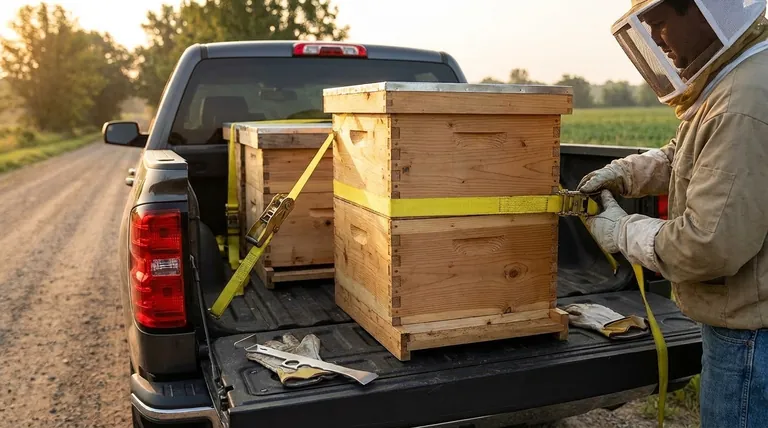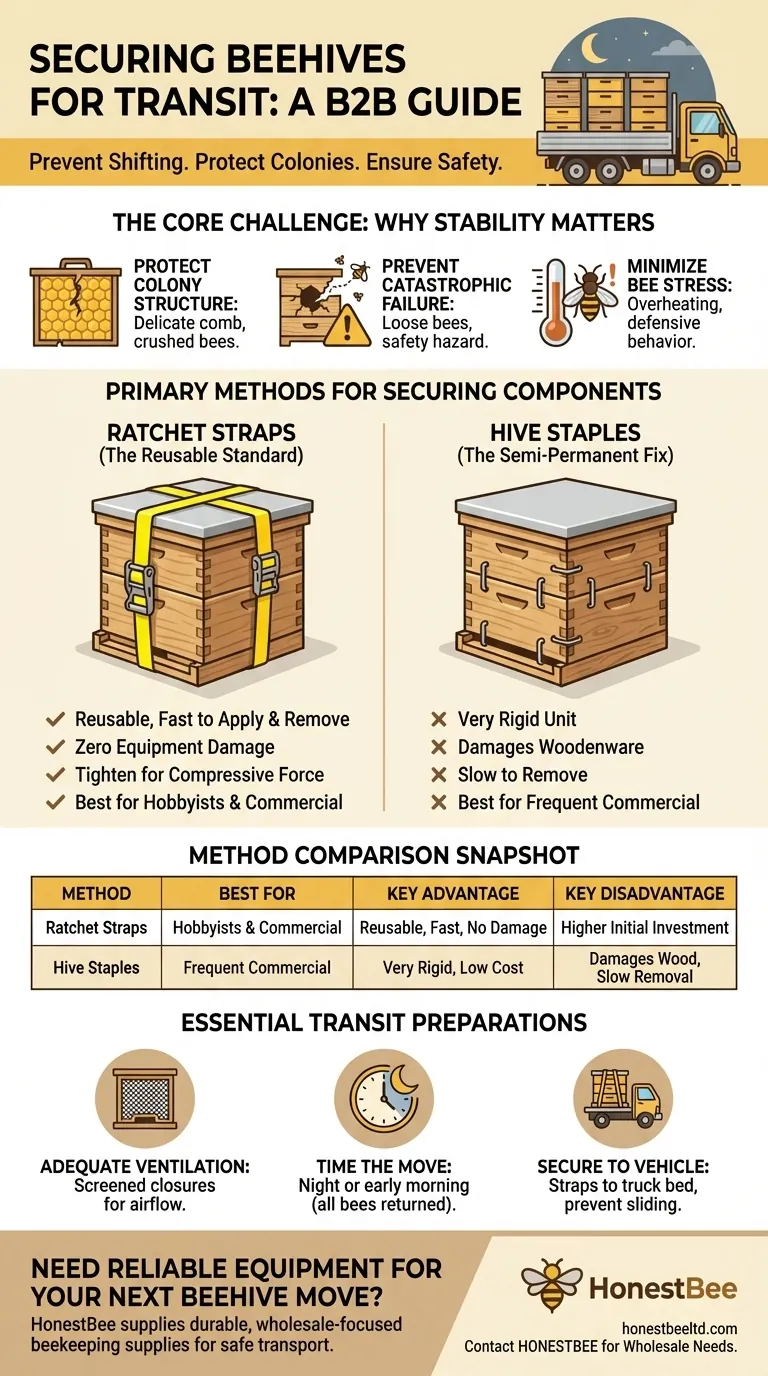To properly secure a beehive for transit, you must fasten the individual components—the bottom board, hive bodies, and cover—into a single, stable unit. The most common and effective methods are using industrial staples to pin the boxes together or cinching the entire hive with one or two ratchet straps. Ratchet straps are generally preferred for their strength, reusability, and the speed with which they can be applied and removed.
Moving a bee colony is a high-stakes operation where failure is not an option. The goal isn't just to keep boxes from shifting, but to protect the colony from stress, prevent catastrophic equipment failure, and ensure the safety of both the bees and the beekeeper.

The Core Challenge: Why Hive Stability is Non-Negotiable
Transporting a hive subjects it to vibrations, bumps, and forces it was never designed to withstand. Without proper securing, the consequences can be severe.
Protecting the Colony's Structure
A hive's internal structure consists of delicate wax comb. Shifting or jarring movements can cause frames to slam together, crushing bees and potentially killing the queen.
Preventing a Catastrophic Failure
If a hive body separates from the bottom board during transit, you will have tens of thousands of defensive bees loose in or on your vehicle. Securing the hive is a primary safety measure.
Minimizing Bee Stress
A stable, secure hive with good ventilation is less stressful for the bees. Overheating and excessive shaking can weaken the colony and make them more defensive upon arrival.
Primary Methods for Securing Hive Components
There are two industry-standard approaches to locking down a hive for a move. Each serves the same purpose but offers different advantages.
Method 1: Ratchet Straps (The Reusable Standard)
Ratchet straps are the most popular method for both hobbyists and commercial beekeepers. A single strap run vertically over the top cover and under the bottom board is often sufficient.
For taller hives or rougher journeys, using two straps is recommended for maximum stability. Their key benefit is that they are infinitely reusable and can be tightened to provide excellent compressive force.
Method 2: Hive Staples (The Semi-Permanent Fix)
Large, 2-inch staples can be driven in at an angle to "stitch" the hive bodies, cover, and bottom board together. Commercial beekeepers sometimes use pneumatic staple guns for this purpose.
This creates a very rigid unit, but it has a significant downside: the staples damage the woodenware and must be pried out upon arrival, which can be time-consuming.
Understanding the Trade-offs
Choosing a method depends on the frequency of your moves, your budget, and the level of convenience you require.
Speed vs. Damage
Ratchet straps are fast to apply and even faster to remove, with zero damage to your equipment. Staples are quick to apply with the right tool but slow and damaging to remove.
Reusability vs. Cost
Straps represent a slightly higher initial investment but can be used for years for countless moves. Staples are extremely cheap for a single use but are not practically reusable.
Security Level
When properly tightened, both methods provide excellent security for the hive components. For extremely long-distance commercial hauls, some operators may even use steel banding, though this requires specialized tools and is overkill for most situations.
Essential Transit Preparations
Securing the hive itself is only one part of a successful move. You must also prepare the colony and the vehicle.
Ensure Adequate Ventilation
Bees generate a tremendous amount of heat. A sealed hive can easily overheat on a warm night, killing the entire colony. Use a screened entrance closure and a screened inner cover or moving screen to ensure airflow.
Time the Move Correctly
The best time to move a hive is at night or very early in the morning. This ensures that all the foraging bees have returned to the hive for the day, preventing you from losing a significant portion of your workforce.
Secure the Hive to the Vehicle
Strapping the hive components together is useless if the entire hive can slide around in your truck bed. Use additional ratchet straps or ropes to firmly secure the hive(s) to the vehicle itself, preventing any movement during the journey.
Making the Right Choice for Your Move
Your choice of equipment should be guided by the nature of the work you are doing.
- If your primary focus is occasional moves as a hobbyist: Use one or two high-quality ratchet straps per hive. This offers the best combination of security, reusability, and convenience.
- If your primary focus is commercial pollination with frequent moves: Ratchet straps are still the standard for their speed, but pneumatic staples are a viable, low-cost alternative if you are optimizing for setup time.
- If your primary focus is a short, one-time move on your own property: Simple hive staples can work, but a ratchet strap is often still easier and avoids damaging your boxes.
Ultimately, a successful move ensures the colony arrives at its new location safe, intact, and ready to thrive.
Summary Table:
| Method | Best For | Key Advantage | Key Disadvantage |
|---|---|---|---|
| Ratchet Straps | Hobbyists & most commercial beekeepers | Reusable, fast, no equipment damage | Higher initial investment |
| Hive Staples | Frequent commercial moves (with pneumatic gun) | Very rigid, low-cost per use | Damages wood, slow to remove |
Need Reliable Equipment for Your Next Beehive Move?
As a commercial apiary or beekeeping equipment distributor, you can't afford failures during transit. HONESTBEE supplies the durable, wholesale-focused beekeeping supplies you need for safe and successful hive transportation.
We provide the high-quality ratchet straps and other essential equipment trusted by professionals to protect your valuable colonies and investment.
Contact HONESTBEE today to discuss your wholesale needs and ensure your next move is a complete success.
Visual Guide

Related Products
- HONESTBEE Advanced Ergonomic Stainless Steel Hive Tool for Beekeeping
- HONESTBEE Professional Long Handled Hive Tool with Precision Cutting Blade
- Professional 3-Bar Frame Grip with Integrated Hive Tool
- Long Langstroth Style Horizontal Top Bar Hive for Wholesale
- Professional Insulated Winter Hive Wrap for Beekeeping
People Also Ask
- How is a hive tool used for scraping and cleaning? Master Hive Maintenance for a Healthy Colony
- What tools are used for cleaning frames? A Beekeeper's Simple 4-Tool Guide
- How should beekeepers handle bees when using a hive tool? Master Calm, Deliberate Techniques
- What is a hive tool and what are its uses? Master Your Hive Inspections with the Essential Beekeeper's Tool
- What are the basic tools for beekeeping? Essential Starter Kit for Safe & Successful Hive Management



















